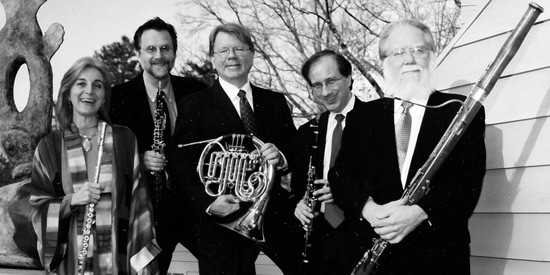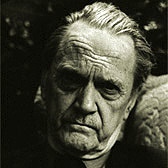
New York Woodwind Quintet, Alec Wilder
The New York Woodwind Quintet Plays the Music of Alec Wilder
Album US 1957 on Golden Crest label
Classical
ABOUT THE NEW YORK WOODWIND QUINTET: The New York Woodwind Quintet is one of the outstanding chamber music groups in the country. In the past ten years it has brought an ever greater appreciation of woodwind chamber music to audiences in the United States through its concert tours. It has also fostered composition in this medium by many of the leading American composers. In the fall of 1956 the New York Woodwind Quintet embarked on a triumphal ten-week tour of South America under the sponsorship of the American National Theater and Academy (ANTA). On this tour the quintet played works of Samuel Barber, Alvin Etler, Ingolf Dahl, Alec Wilder and other contemporary American composers. The members of the quintet, Samuel Baron, flute, Jerome Roth, oboe, David Glazer, clarinet, John Barrows, horn, and Bernard Garfield, bassoon are individually acknowledged to be at the forefront of their professions as solo players and chamber music artists. As a member of the performing group on this LP I find myself at somewhat of a disadvantage in writing the cover notes. I can’t bring myself to say, “Now this performance you are about to hear is the greatest thing ever.” It wouldn’t be modest. But, as a member of the performing group here is something I can do. I would like to present to you Alec Wilder as we know him. Alec Wilder is a man who likes to write music for his friends. Now take last summer (1956). We were in Milwaukee giving classes in woodwind chamber music at the University of Wisconsin. The five of us in the New York Woodwind Quintet were teaching student players on flute, oboe, clarinet, bassoon and french horn. We organized them into different ensembles and coached their rehearsals. There were quintets, quartets, sextets and octets going, and smaller ensembles were made up ad lib. Along comes Alec Wilder. Fresh from the West Coast or somewhere he shows up in Milwaukee one warm summer day and announces that he would like to rest up in our dormitory for a while. Well and good. But instead of resting, he listens in on the woodwind classes. Very much impressed by the talent and enthusiasm of the youngsters, Alec begins to write,—and here is a partial list of what he wrote between June 25 and July 5, 1956 in Marietta House, U. of Wis., Milwaukee: a suite of solo pieces for woodwind quintet (included on this LP) two pieces for four oboes, arrangements for fun of “Happy Birthday to You” (it was somebody’s birthday), “When I Grow Too Old To Dream”, “Who”, “Good Night Sweetheart”, “Good Night Ladies”, “Dinah” (included on this LP), “I Know That You Know”, “All Through The Night”. Also, a piece for four bassoons, two duets for horn and bassoon, and a piece for flute and clarinet. Not only did he write all this music, but he copied parts and supervised rehearsals. To my mind this represents a peak of a sort for gebrauchmusik. Music to use. Music to enjoy. Music to have fun with. Music to order and on the spot. Now many critics complain about Alec Wilder because they can’t pin him down to one medium or style. They can’t classify him. It is actually irritating to some people that a composer doesn’t fit into his prescribed pigeonhole. Does Wilder write serious music? Or does he write popular music? Does he write jazz? (The answer to all these questions is, yes, at times.) Try to put him into any one pigeonhole and he laps over on both sides. Wilder has written opera and chamber opera, he has written popular songs, he has written chamber music, he has written film scores (such as “Grandma Moses” and “The Schweitzer Story”) and he has written jazz arrangements for some of our most famous jazz soloists and groups. I am given to understand that no advertising of rival recording companies will be tolerated on the back of this particular record, but still I am sure that the reader will not have to be reminded of much of the music that Wilder has written. Perhaps the reader will remember the epoch-making octets for woodwinds, rhythm and harpsichord (way back in the old days). Perhaps he will remember the tasty suite of pieces put together under the rubric of children’s music, explaining the instruments of the orchestra. (I am mentioning only those works that I remember best myself.) Well, the way we look at it is this: Alec writes all of a piece. Whatever the medium he employs, whatever the assignment he undertakes, he expresses both it and himself fully. He does not compartmentalize his abilities by saying, “Now I will write something serious. Now I will write something popular. Now I will write something commercial . . .” (Which is something that many otherwise gifted writers do, with unfortunate results.) Alec writes it as he has to write it. Listen to music of Wilder’s, in any field whatever, and you will be strongly aware of the true personality of the composer. I think the music on this record will bear this out. We hear of Wilder a full, four-movement chamber work, a suite of five shorter pieces, three transcriptions of works by early classical composers, and finally an arrangement of an old standard popular song—all of these works for woodwind quintet. Despite the varied nature of these compositions you will see that they are all integral expressions of the composer. Consider first the quintet (side A). This is actually the second full quintet that Wilder has written for woodwinds and dates from the spring of 1956. We have already played it quite extensively at concerts. In the middle of the first movement (which is prevailingly nervous and rhythmic) a slow and lazy tune breaks in. This theme becomes the unifying motive of the entire work, appearing in every movement,—but always unexpectedly, and always in a different guise. In the tender slow movement it seems like a lullaby; in the jumpy third movement, it takes on a high hilarity. Wilder’s longer forms take some listening, but the listener is never in doubt that there is a powerful essential unity. The Suite for Woodwind Quintet (side B) dates from the summer of 1956 as described above. These are five short forms and they comprise portraits or personality sketches: Of whom? Why, of the instruments themselves and of the way they behave in quintet. On first hearing perhaps the most attractive are the birdlike flute piece and the clownish bassoon piece, but the reader is urged not to neglect the deeper content of the slower pieces, especially the clarinet solo. Like so many of Wilder’s things these pieces originally had private joke titles (for instance, the oboe piece was called “Waxing Roth” in honor of our oboist, Jerome Roth), but for posterity, as represented by this recording, we have given them formal titles. Readers who are interested in the full set of original titles may apply in writing to Crest Records, Inc. Dinah was originally an arrangement for fun. Our quintet adapts itself somewhat lugubriously to this erstwhile happy standard. Listen carefully, now, and see if you hear a resemblance between the last measure of Alec’s arrangement of Dinah, and the first measure of the horn solo from the suite. The three compositions by Henry Purcell, K.P.E. Bach and Dietrich Buxtehude are settings for woodwind quintet by Wilder. In the early days of our concert career we found ourselves often in need of opening music of a classical nature. Wilder volunteered to provide a series of transcriptions for us of which the three on this record soon became staple items in our repertoire. Notes by Samuel Baron
Musicians
 | New York Woodwind Quintet , album by |
 | Alec Wilder , 1907-1980 US album by, arranged by |
Album Tracks
| No | Title | Artist | Composer | Duration |
|---|---|---|---|---|
| 1 | Quintet No. 2 For Woodwinds: Allegro | New York Woodwind Quintet, Alec Wilder | 3:54 | |
| 2 | Quintet No. 2 For Woodwinds: Andante E Rubato | New York Woodwind Quintet, Alec Wilder | 4:30 | |
| 3 | Quintet No. 2 For Woodwinds: Presto | New York Woodwind Quintet, Alec Wilder | 2:09 | |
| 4 | Quintet No. 2 For Woodwinds: Allegro | New York Woodwind Quintet, Alec Wilder | 3:57 | |
| 5 | Suite For Woodwinds: Scherzo For Flute | New York Woodwind Quintet, Alec Wilder | 1:28 | |
| 6 | Suite For Woodwinds: Andante For Oboe | New York Woodwind Quintet, Alec Wilder | 1:56 | |
| 7 | Suite For Woodwinds: Air For Clarinet | New York Woodwind Quintet, Alec Wilder | 2:46 | |
| 8 | Suite For Woodwinds: Blues For Horn | New York Woodwind Quintet, Alec Wilder | 1:54 | |
| 9 | Suite For Woodwinds: Buffoonery For Bassoon | New York Woodwind Quintet, Alec Wilder | 0:58 | |
| 10 | Dinah | New York Woodwind Quintet, Alec Wilder | Harry Akst | 2:22 |
| 11 | Pavan | New York Woodwind Quintet, Alec Wilder | Henry Purcell | 2:13 |
| 12 | Chorale Prelude Jesu, Joy And Treasure | New York Woodwind Quintet, Alec Wilder | Dieterich Buxtehude | 2:38 |
| 13 | Rondo Andantino | New York Woodwind Quintet, Alec Wilder | Carl Philipp Emanuel Bach | 3:54 |
ArtistInfo App
ArtistInfo for iOS and ArtistInfo for Mac are presenting musicians, composers and producers that are envolved in the musical work that you are listening to in Apple Music, iTunes, or Spotify. Discover new music via the network among artists. Manage your favorite musicians and albums via iCloud and share recommendations with your friends via email, AirDrop, or Social Media.Acknowledgements
To all the music fans that are contributing on Discogs, MusicBrainz and Wikipedia. Thanks to Franz Flückiger for providing Storygram used to visualize band membership.Other Search Results
| New York Woodwind Quintet, Alec Wilder - The New York Woodwind Quintet Plays the Music of Alec Wilder US Classical |